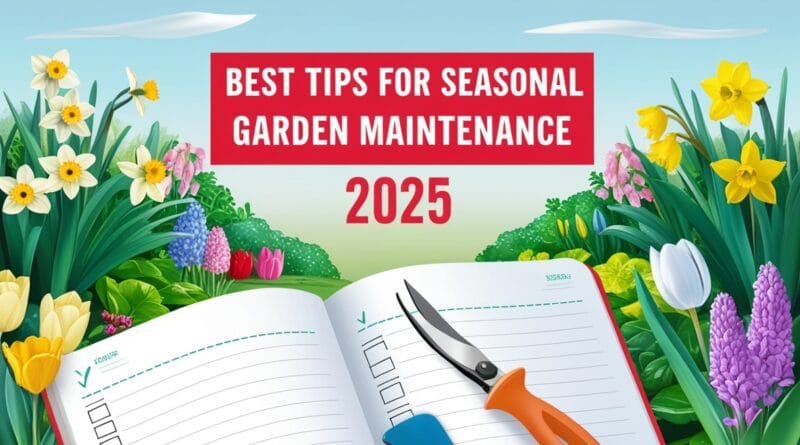Top Tips for Seasonal Garden Maintenance 2025
Table of Contents
Preparing Your Garden for Spring
Best Tips for Seasonal Garden Maintenance Proper preparation in late winter ensures a thriving garden in spring.
- Clean and Clear: Remove debris, dead leaves, and fallen branches.
- Tool Maintenance: Sharpen, clean, and oil gardening tools.
- Soil Preparation: Test soil pH, add compost, and till the soil.
- Planting Plans: Determine which plants or vegetables to grow.
- Mulching: Apply mulch to control weeds and retain moisture.
- Pruning: Prune dead or damaged branches from trees and shrubs.
- Pest Control: Check for pests and treat as necessary.
Attention to these tasks guarantees a successful gardening season ahead.
Essential Spring Garden Tasks
Spring is a critical season for garden maintenance. Here are essential tasks to ensure a thriving garden:
- Soil Preparation: Test soil pH and amend as needed. Turn the soil to aerate and incorporate organic matter.
- Weed Control: Remove weeds early before they establish roots. Use mulch to suppress weed growth.
- Pruning: Trim dead branches and shape shrubs and trees to encourage healthy growth.
- Planting: Sow cool-season vegetables and annual flowers. Plant new perennials and trees.
- Fertilizing: Apply a balanced fertilizer to provide essential nutrients for plant growth.
- Pest Inspection: Check for pests and treat infestations promptly to protect plants.
Spring tasks set the foundation for a vibrant garden throughout the year.
Summer Maintenance Tips
During the summer months, garden maintenance requires vigilant monitoring and timely action to ensure plant health and growth.
- Watering Schedule: Consistent watering is crucial. Early morning or late afternoon is best to minimize evaporation.
- Mulching: Apply mulch to retain moisture, suppress weeds, and regulate soil temperature.
- Pest Control: Regularly inspect plants for pests and use organic pesticides as needed.
- Pruning: Trim dead or diseased branches to promote air circulation and reduce the risk of infection.
- Soil Fertilization: Use compost or balanced slow-release fertilizers to support plant nutrition.
- Weed Management: Remove weeds promptly to prevent competition for nutrients.
Watering Strategies for Hot Months
Maintaining adequate moisture levels in the garden is crucial during hot months. Employing efficient watering techniques ensures plants remain healthy even in extreme temperatures.
- Early Morning Watering: Watering plants early reduces water loss due to evaporation and prevents mildew.
- Deep Watering: This encourages deeper root growth, making plants more drought-resistant.
- Mulching: Applying mulch around plants conserves moisture and cools the soil.
- Drip Irrigation: This method targets the roots directly, using water efficiently and minimizing wastage.
- Regular Inspections: Frequently check soil moisture to adjust watering schedules as needed.
- Shading: Use shade cloth or plant shade-loving species to reduce heat stress on plants.
Managing Garden Pests and Diseases in Summer
Maintaining a healthy garden during summer requires diligent management of pests and diseases. Key strategies include:
- Regular Inspections: Conduct frequent checks for signs of pests and disease, such as discolored leaves or unusual spots.
- Biological Controls: Introduce beneficial insects like ladybugs and nematodes to naturally reduce pest populations.
- Proper Watering Techniques: Avoid over-watering. Instead, use drip irrigation to minimize conditions favorable to diseases.
- Organic Pesticides: Utilize neem oil or insecticidal soaps as non-toxic alternatives to chemical pesticides.
- Companion Planting: Plant species that deter pests, such as marigolds and basil, around susceptible plants.
Preparing for Fall: What You Need to Know
Fall is a critical period for garden maintenance, demanding specific tasks to ensure plant health and soil quality. Here are essential steps:
- Soil Preparation: Test soil pH; amend with compost or fertilizer as needed.
- Planting: Opt for hardy perennials, bulbs, and cool-weather vegetables.
- Pruning: Prune dead or diseased branches to prevent winter damage.
- Watering: Reduce watering frequency but ensure deep, infrequent waterings.
- Mulching: Apply mulch to protect root systems and regulate soil temperature.
- Clean Up: Remove fallen leaves and debris to prevent pests and diseases.
- Tool Maintenance: Clean and store garden tools to prolong their lifespan.
Fall Planting and Transplanting Guide
Autumn provides the perfect window for planting and transplanting. Cooler temperatures allow plants to establish roots without the stress of summer heat. Follow these tips for optimal results:
- Timing: Aim to plant 6-8 weeks before the first frost.
- Soil Preparation: Enrich soil with compost and ensure proper drainage.
- Plant Selection: Focus on perennials, trees, and shrubs suited for fall planting.
- Watering: Water thoroughly after planting; maintain moisture until the ground freezes.
Pay close attention to each plant’s specific needs to ensure a successful transition. With careful planning, a flourishing garden is attainable.
Winter Protection for Your Garden
Winter can be harsh on gardens, necessitating careful preparation to ensure plants survive. Gardeners should:
- Mulch Heavily: Apply a thick layer of mulch around plants to insulate soil, retaining moisture and warmth.
- Water: Give plants a deep watering before the first frost to ensure they are well-hydrated through cold months.
- Cover Plants: Use frost cloths, burlap, or old blankets to cover vulnerable plants during extreme cold snaps.
- Prune Wisely: Trim dead or weak branches to reduce winter damage but avoid heavy pruning as it can stimulate new growth.
- Check and Clean Tools: Clean and sharpen garden tools to prevent rust and ensure they’re ready for spring.
Tools and Equipment Maintenance
Proper care of garden tools and equipment prolongs their lifespan and enhances efficiency. Regular cleaning after each use prevents rust and dirt buildup. Sharpening blades and pruning shears ensures precise cuts, reducing plant damage. Lubricating moving parts with appropriate oils or greases maintains smooth operation. Storing tools in a dry, safe place prevents rust and other damage. Inspecting for any wear or damage before season starts can help in addressing issues promptly. Power equipment should be serviced periodically by professionals, ensuring they are in good working condition. Investing in quality tools yields long-term benefits for garden maintenance.
Organic and Eco-Friendly Practices for Year-Round Care
Incorporating organic and eco-friendly practices enhances the sustainability of garden maintenance. These methods support plant health, conserve resources, and protect the environment.
Pest Control
- Natural Predators: Introduce beneficial insects like ladybugs and lacewings.
- Companion Planting: Utilize plants that deter pests naturally, such as marigolds and basil.
Soil Health
- Composting: Use kitchen scraps and yard waste to create nutrient-rich compost.
- Mulching: Apply organic mulch to retain soil moisture and suppress weeds.
Water Conservation
- Rain Barrels: Collect and use rainwater for irrigation.
- Drip Irrigation: Install systems to reduce water waste and efficiently hydrate plants.

